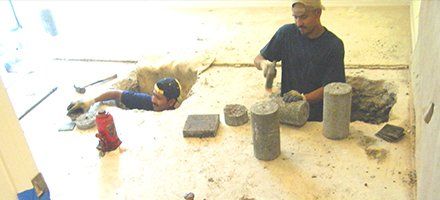Helping you avoid foundation problems
With decades of experience in helping to maintain and repair home foundations, All American Foundation Repair & Drainage INC of Duncanville, TX has seen many of the "usual suspects" that contribute to foundation damage. By keeping a lookout for these common problem signs, and beginning to institute your own preventative maintenance program, you can head off many expensive problems before they start!

Drainage problems
Drainage: Your yard should slope away from the house and wall so that it doesn't interfere with drainage.
Gutters: They should be able to handle the roof runoff and need to be cleared of leaves and debris.
Replace them if they're rusted or broken.
Downspouts: Water should be discharged at least 3 feet away from the building. Buried (French) drains may be necessary to keep water away from the foundation.
Watering (should supplement rainfall)
Automatic sprinklers: Your sprinklers should be checked to ensure there are no leaks and that they are working properly. You may need to change the number, location, and adjustment of the heads to maintain stable soil.
Shrubs and flowers: You should check beds close to the house to maintain proper moisture. Gaps between the soil and foundation indicate that there could be a foundation problem.
Trees: Trees extract water through their roots every day of the year. During extremely dry periods, you should water them. Barriers can be installed that will keep potentially troublesome roots away from the foundation.
Foundation repair and maintenance tips
Foundations and water: Expansive soils act like a sponge; as they absorb water (usually in the winter and spring) they swell and as they lose water (in the summer) they shrink.
As the soil under a house shrinks and swells with the seasons, the house and foundation will move up and down. As long as the foundation movement is not great enough to damage the house and / or foundation, it is not a problem. If the up and down movement of a foundation always returns the foundation to its original level position, then damage to the house and foundation may appear and disappear on a regular basis.
Following a controlled watering program can help stop seasonal house and foundation damage. By keeping the moisture content of the soil under the foundation constant, foundation movement can often be stopped. All American Foundation Repair & Drainage INC has written this to assist the homeowner in performing a simple foundation preventive maintenance program.
The goal of a foundation watering program is to maintain a constant level of moisture in the soil under the house and foundation. The best way to water a foundation is to install a buried foundation watering system. If you do not want to go to the expense of installing a buried watering system, soaker hoses will provide you with many of the same benefits. The best way to use a soaker hose is to bury a soaker hose three inches deep, one foot from the edge of your foundation. Placing the hose a short distance from the foundation allows the water to soak into the soil evenly.
The hose should not be placed against the foundation. When soil has dried and cracked, water can travel along the cracks for several feet in all directions. If the soil around your foundation is dried and cracked, then water placed next to the foundation will run through the cracks and accumulate at the bottom of the grade beam (the thick portion of the foundation that is under the exterior walls). In some cases, an accumulation of water in the soil at the base of a foundation can cause the soil to lose some of its load bearing capacity. If the soil loses enough load bearing capacity, the house will sink into the ground.
Obviously, it is necessary to water more during hot, dry weather and less during cold, damp weather. The amount of water required to keep a foundation stable during the summer can be surprisingly large. A single large tree can remove as much as 150 gallons of water, or almost 20 cubic feet of water, from the soil each day. Shrubs and other plants can also remove large quantities of water. During persistent hot dry weather, it may be necessary to water a foundation daily. Watering should supply enough water to keep the moisture content in the soul under the foundation constant. If the amount of water applied is only enough to keep the surface damp, the watering program will not work. Obviously, the homeowner is the only one who can weigh the benefits of controlling foundation movement versus the increased size of the water bill.
Upheaval: Water that collects under the foundation, regardless of origin, is a major problem. This water is confined, accumulative, and particularly serious; it accounts for a high percentage of all failures. The source can be either domestic leaks or nature. Foundation failures resulting from this excessive water under the foundation are classically termed "upheaval."
"Upheaval" relates to the situation in which the internal and on rare occasion, external areas of the foundation raises above the as-built position. In high-plasticity soils this phenomenon results, almost without exception, from the introduction of moisture under the foundation. Once the slab heaves, the reinforcing steel is stressed into what amounts to a permanent elongation.
Don't forget - All American Foundation Repair & Drainage INC offers 10% discounts to all fire fighters, police, military, and seniors!
Call to schedule your FREE foundation repair estimate.
972-709-6300
